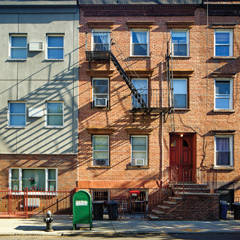
Evaluation Period: 2000-2018
Total Awarded: $42.25 million
Total Number of Program Related Investments: 22
Geographic Focus: United States
Background
Most of the federal rental subsidies used to make properties affordable end, or can be terminated, after a set time period. This has led to the gradual loss of units from the subsidized inventory as neighborhoods with strong rental markets convert to market-rate housing. By the late 1990s, this loss of units had contributed to a growing shortage of affordable housing that left millions of low-income Americans struggling to afford their rent.
In 2000, we launched the Window of Opportunity (WOO) Initiative in response to widely shared concerns over the loss of affordable rental housing. The Initiative employed a range of strategies designed to help preserve affordable rental units in multiple communities nationwide and to raise the profile of affordable rental housing as an essential part of a balanced national housing policy. One key component of the Initiative was to commit $42.25 million in program related investments (PRIs) to 20 nonprofit housing developers working in at least 40 U.S. states and the District of Columbia.
A PRI is a below-market interest rate loan made by a foundation primarily to further its charitable purposes, not to produce income. Through WOO, we made PRIs designated to one of two eligible uses at the entity level: for organizational working capital, intended to expand and strengthen operations of borrowers; and for pre-acquisition/bridge capital, to be used in the process of acquiring at-risk properties prior to the developers obtaining permanent financing. They had low interest rates (ranging from one to three percent), long terms (generally 10 years), and were unsecured. These characteristics combined to make these PRIs, which averaged $2.1 million per organization, unusually flexible sources of equity-like capital for their recipients. Overall, we intended these PRIs to strengthen the financial and organizational capacity of the recipients to engage in affordable housing preservation efforts at scale.
What We Evaluated
A 2016 study led by the RAND Corporation evaluated the Initiative as a whole, though it did not closely examine the effect of the Initiative’s PRIs in strengthening the capacity of nonprofit developers to preserve affordable housing. We commissioned Abt Associates and VIVA Consulting to address the following four evaluation questions focused on the Initiative’s PRIs:
- To what extent and how did the WOO PRIs enable borrowers to expand preservation activities or pursue new preservation strategies? How did this capital help borrowers leverage other sources of funding to further their preservation efforts?
- Did access to entity-level financing influence borrowers’ organizational capacity?
- To what extent were the PRIs associated with changes in borrowers’ (i) balance sheet strength or profitability, (ii) sources of subsidy, or (iii) ability to access capital?
- To what extent do other large nonprofit affordable housing developers have access to entity-level financing? How have they used that financing to support their activities and growth?
What We Learned
The evaluation found the PRIs improved organizations’ capacity, and the program demonstrates the importance of equity-like capital as one piece of the solution to affordable housing. High-level takeaways from the evaluation include:
- The PRIs enabled developers to pursue much more preservation activity than they would otherwise have been able to conduct.
- WOO borrowers have accessed more than $5.6 billion in other non-PRI funding in the preservation transactions they completed during the terms of their PRIs.
- Many WOO borrowers used the PRIs to make major capital investments and increase staff capacity that improved their ability to preserve affordable housing.
- WOO borrowers are emerging from their loan terms in much stronger financial positions than when they entered them.
- The WOO Initiative demonstrated that entity-level investments could facilitate significant affordable housing preservation and development.
- Between 2000 and 2018, other large nonprofit affordable housing developers that did not participate in WOO gained access to entity-level capital in other ways, albeit somewhat later than WOO borrowers.
- The Initiative demonstrated that, with access to the equity-like capital of a PRI, affordable housing developers could survive–and even thrive–in the aftermath of the Great Recession of the late 2000s.
MacArthur's evaluation philosophy ›



